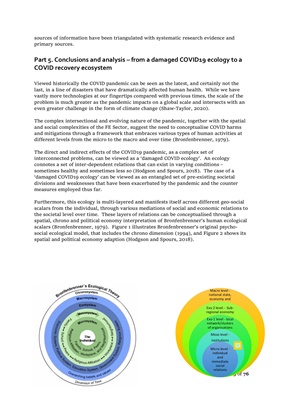
Page 9 of 76
sources of information have been triangulated with systematic research evidence and
primary sources.
Part 5. Conclusions and analysis - from a damaged COVID19 ecology to a
COVID recovery ecosystem
Viewed historically the COVID pandemic can be seen as the latest, and certainly not the
last, in a line of disasters that have dramatically affected human health. While we have
vastly more technologies at our fingertips compared with previous times, the scale of the
problem is much greater as the pandemic impacts on a global scale and intersects with an
even greater challenge in the form of climate change (Shaw-Taylor, 2020).
The complex intersectional and evolving nature of the pandemic, together with the spatial
and social complexities of the FE Sector, suggest the need to conceptualise COVID harms
and mitigations through a framework that embraces various types of human activities at
different levels from the micro to the macro and over time (Bronfenbrenner, 1979).
The direct and indirect effects of the COVID19 pandemic, as a complex set of
interconnected problems, can be viewed as a 'damaged COVID ecology'. An ecology
connotes a set of inter-dependent relations that can exist in varying conditions -
sometimes healthy and sometimes less so (Hodgson and Spours, 2018). The case of a
'damaged COVID19 ecology' can be viewed as an entangled set of pre-existing societal
divisions and weaknesses that have been exacerbated by the pandemic and the counter
measures employed thus far.
Furthermore, this ecology is multi-layered and manifests itself across different geo-social
scalars from the individual, through various mediations of social and economic relations to
the societal level over time. These layers of relations can be conceptualised through a
spatial, chrono and political economy interpretation of Bronfenbrenner's human ecological
scalars (Bronfenbrenner, 1979). Figure 1 illustrates Bronfenbrenner's original psychosocial
ecological model, that includes the chrono dimension (1994), and Figure 2 shows its
spatial and political economy adaption (Hodgson and Spours, 2018).
Macro level national
state,
economy and
policy
Exo 2 level - Subregional
economy
Exo 1 level - local
network/clusters
of organisations
Meso level institutions
Micro level individual
and
immediate
social
relations